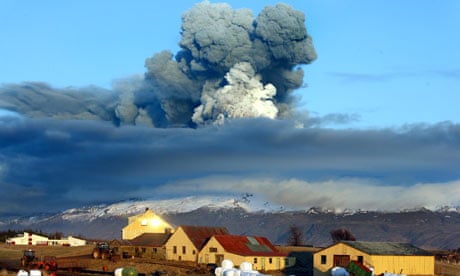Just before the second eruption of Eyjafjallajökull in Iceland last week, I was standing in the middle of the night in a deep black canyon with three companions straining to hear the volcano whisper its menace. A few hundred yards above us, a blizzard had smothered the mountain and extinguished the violent red glow I had seen from a plane three days before.
We had tried to get up the 5,466ft volcano in our guide Saeli's super-jeep but were defeated by the weather and were now making do with the relative hush of a place called Thorsmorg, where JRR Tolkien had once stood and pondered the sheer black cliffs. We were aware of the occasional muffled explosion and the heavy, sulphurous scent of the beast. Saeli made me feel the rock either side of the gorge, which had been spewed out in a previous explosion and is much denser than normal larva. He explained that the magma has to punch its way through 200 yards of accumulated ice, which causes the material to compact.
I asked him what he would do if the mountain exploded like it had in the winter of 1821, an eruption that lasted for a full two years. He rubbed his chin and began to calculate the distance to the road (14 miles), the top speed of his super-jeep over this terrain of rocks and torrents (20-25mph), the speed of the flood from a melting glacier (anything over 30mph), and concluded that we would not make it. The only chance would be to leave the jeep and climb to escape the flash flood of rocks, new lava, ice, mud and water. But then we would have the ash to contend with, to say nothing of the lightning that usually accompanies a major eruption.
Eyjafjallajökull (which translates as Island Mountain Glacier and is pronounced AYA-feeyapla-yurkul) was an extremely dangerous place, even before the moment last Wednesday when the fissure as long as the Mall in London became a fully fledged volcano shooting ash four-and-a-half miles into the sky. Two days previously, Saeli had been part of a team searching for three Icelandic volcano enthusiasts who had been trapped in a storm.
Saeli found the body of one man, who had gone looking for a phone signal and perished in the cold. His female companion, who left the vehicle for a pee, also died. A second woman who had stayed in the jeep was clinging to life when they found her. Turns out they had run out of petrol. Pretty much everything Saeli predicted has now happened. The mountain changed shape. Thousands of square miles are covered in ash. All the local farms and settlements have been evacuated, the sheep and stocky Iceland horses rounded up and carried to pastures in the north and east.
The road where I stood last Sunday afternoon watching the light of the volcano pulse through the clouds like a summer storm has been swept away by the melting glacier. What had been a tourist attraction for two weeks, with helicopter rides, chefs cooking steaks beside the volcano, and Jeremy Clarkson driving over hot lava for Top Gear, has become a fully fledged hazard that will seriously disrupt life in Iceland for a long time and is costing the airline industry £200m a day.
I left before the big eruption, but even if I had been trapped in that magnificent wilderness there is a lot in me that would take pleasure from Earth's interruption of mankind's hectic schedule. Except for the odd heavy fall of snow and flood, we are hardly inconvenienced by natural events in Britain, but in Iceland, where they live on the surface of what sometimes seems like an entirely different planet, you become aware of nature's power to assert itself over our miserably self-important affairs and to dispose of life in a few seconds.
Some years ago my friend Simon Winchester was giving a lecture in the US about what might happen if the dormant volcano under Yellowstone Park erupted. It would, he said, kill a vast number of people in the world. "Americans too?" asked a woman in the audience. She had clearly not heard of the late Permian extinction, sometimes referred to by geologists as the Great Dying, which occurred 250 million years ago and almost certainly involved vast volcanic activity.
Underwater volcanoes may well be the source of life and volcanic activity on land may end it, which is worth remembering as we curse the cancellation of Ryanair's service to Perugia and regret the absence of a few foreign delicacies from the supermarket shelves.
For me it was an unimaginable privilege to be in that breathtaking wilderness, to feel the breath of the beast and hear it stir before last Wednesday's eruption. But instead of getting worked up about the airline industry, we should think ourselves lucky that, as volcanoes go, this is not much more than an inflamed pimple.

Comments (…)
Sign in or create your Guardian account to join the discussion